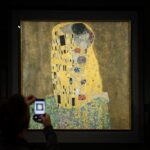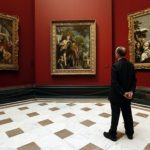Those who visited the National Gallery’s Vermeer and Music exhibit in London last year will have seen one of his rarely seen paintings, The Music Lesson, on loan from Her Majesty. But it’s fairly certain that no one looked at that painting with the same intensity as Texas-based, self-made computer optics millionaire Tim Jenison when the Queen had granted him a 30-minute private viewing at Buckingham Palace.
For Tim, who had never held a paintbrush, was about to recreate that painting from scratch in an attempt to explain how Vermeer achieved photo-realism 150 years before the invention of photography.
His eight-year experiment has been made into a documentary, Tim’s Vermeer, produced and directed respectively by the magic duo Penn and Teller. They document the painstaking nature of Tim’s experiment comprehensively, but fail to explore the ramifications of the end result.
Of all the Dutch artists who, in the mid 17th century, began depicting ordinary middle class figures within small, detailed interior spaces, Vermeer is the most venerated for the astonishing detail and indescribable effects of light and colour. In 1935, Picasso wrote: ‘I’d give the whole of Italian painting for Vermeer of Delft,’ although in his lifetime, Vermeer struggled to sell his art.
Many artists, collectors and art historians have long thought that he used a camera obscura. In 2001 Professor Philip Steadman’s book Vermeer’s Camera caused quite a stir for suggesting that, using ‘reverse perspective, Vermeer had projected the geometry and décor of his studio in Delft on the back wall of the room using a lens and traced it.
Five years later, David Hockney, a British artist who half way through his career started using photography and computers to make art, wrote Secret Knowledge: Rediscovering Technique of the Old Masters. Hockney argued that in Vermeer’s day and art and science were intertwined, and that, far from ‘cheating’ Vermeer was all the more of a genius for combining his knowledge and skills at both.
Inspired by the challenge of Hockney’s book, the inventor in Jenison prompted him to embark on his experiment. He learned some Dutch, spent time in Delft, learned to make the pigments and paints available in Vermeer’s day, and recreated the setting of The Music Lesson in an outbuilding on his property, (his daughter modelled as the girl), to the exact dimensions of the room used in most of Vermeer’s paintings. He also interviewed many experts in Holland and England, including three shown in the documentary: Hockney, Steadman and Colin Blakemore, Emeritus Professor of Neuroscience at Oxford.the famous neurobiologist specialising in vision and the brain.
But Jenison realised that the camera alone was not sufficient to produce the range of colours and sharpness of detail visible in the paintings. After further experimentation, he added two carefully placed and shaped mirrors that enabled him to see the threads in the fabric of the painting’s carpet. While all this research and preparation was meticulous, hard work, it was nothing compared to the actual painting, so physically demanding and tiring that it took nearly half a year.
Taking into account the slow process, and the fact that Vermeer supplemented his meagre income from painting by dealing in art, it’s not surprising that only 35 paintings are attributed to him in his short life. His (surviving) painting is from 1656 and he died in 1675 at the age of 43.
Tim’s experiment has moved us closer to understanding the mechanics of Vermeer’s technique, but not to understanding or defining the power of the particular arrangement he put in place with lines, colour and brushstrokes.
Early on, with his camera obscura in place, Tim faced the obvious challenge that ‘you can’t paint with light, you paint with paint.’ Perhaps the mystery of Vermeer is that he found a way to paint with light.
by Joyce Glasser, Mature Times film reviewer




